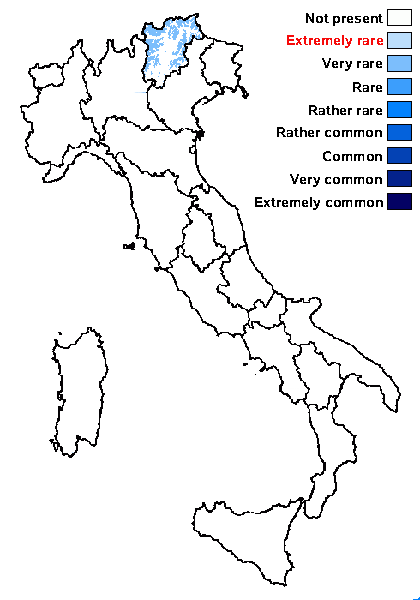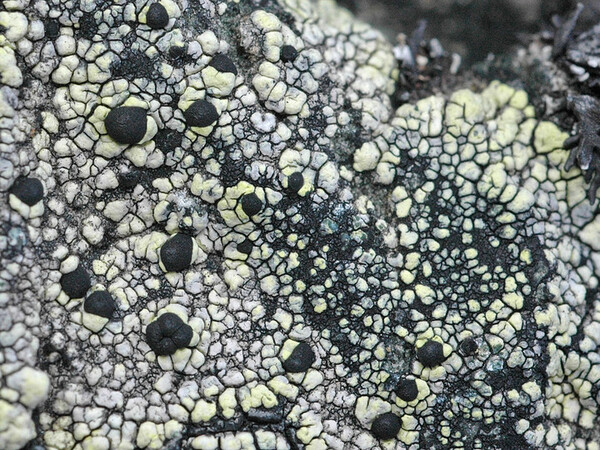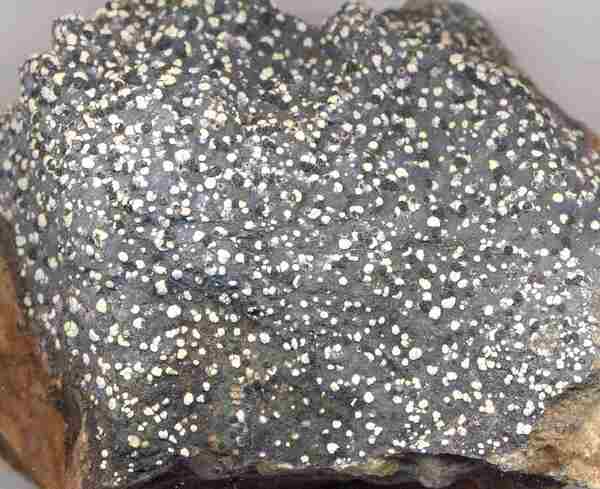Rhizocarpon inarense (Vain.) Vain.
Hedwigia, 37: 86, 1898. Basionym: Lecidea chionophiloides subsp. inarensis Vain. - Meddel. Soc. Fauna Flora Fenn., 10: 124, 1883.
Synonyms:
Distribution: N - TAA (Nascimbene 2005).
Description: Thallus crustose, episubstratic, whitish yellow-green, greyish-yellow or straw-coloured, rarely bluish yellow to bluish green, often whitish-pruinose, areolate, forming 2-5 cm wide patches delimited by a black prothallus which is also visible as a hypothallus between the areoles. Areoles round and convex to angular and flat, widely dispersed to contiguous, 0.4-1 mm wide, 0.1-0.3 mm thick, smooth. Cortex 15-30 µm thick; medulla white, I- or I+ faintly blue. Apothecia frequent, lecideine, arising between the areoles, mostly round, 0.5-1.2 mm across, with a black, weakly to strongly convex, epruinose disc and a thin, finally often excluded proper margin. Proper exciple brownish red, K+ intensifying red; epithecium dirty green to bluish green, K- or K+ intensifying green; hymenium colourless 110-150 µm high, K/I+ blue; paraphysoids strongly coherent, richly branched and anastomosed, the apical cells slightly clavate; hypothecium dark brown, 70-150 µm high, K-. Asci 8-spored, clavate, fissitunicate, with a well-developed tholus that is K/I- in lower part and K/I+ blue near the apex, lacking an ocular chamber, Rhizocarpon-type. Ascospores 1-septate, dark brown, ellipsoid, 21-30 x 10-12 µm, halonate at least when young. Photobiont chlorococcoid. Spot tests: medulla K+ yellow turning blood-red, C-, KC-, P+ pale yellow. Chemistry: cortex with rhizocarpic acid, medulla with norstictic acid and sometimes with traces of psoromic or gyrophoric acids.Note: a circumboreal to arctic-alpine species of siliceous rocks, reaching the nival belt in the Alps, where it is probably more widespread.
Growth form: Crustose
Substrata: rocks
Photobiont: green algae other than Trentepohlia
Reproductive strategy: mainly sexual
Commonnes-rarity: (info)
Alpine belt: very rare
Subalpine belt: very rare
Oromediterranean belt: absent
Montane belt: absent
Submediterranean belt: absent
Padanian area: absent
Humid submediterranean belt: absent
Humid mediterranean belt: absent
Dry mediterranean belt: absent

Predictive model
Herbarium samples
Growth form: Crustose
Substrata: rocks
Photobiont: green algae other than Trentepohlia
Reproductive strategy: mainly sexual
Commonnes-rarity: (info)
Alpine belt: very rare
Subalpine belt: very rare
Oromediterranean belt: absent
Montane belt: absent
Submediterranean belt: absent
Padanian area: absent
Humid submediterranean belt: absent
Humid mediterranean belt: absent
Dry mediterranean belt: absent

Predictive model
| Herbarium samples |
 INDEX FUNGORUM
INDEX FUNGORUM
 GBIF
GBIF
 DOLICHENS
DOLICHENS




